- Learning time
- 30 minutes
- First play time
- 90 minutes
Tajuto
Designed by: Reiner Knizia
In Tajuto, players are Buddhist monks working together to build a large spiritual garden, populated by eight Pagodas. Inspired by real-world history, the game then departs from reality somewhat by having the monks all striving to beat each other to being the most spiritual – surely some contradiction there! – and constructing pagodas, layer on layer, by the bizarre method of plunging their hand into a bag and removing what they think is the right size, and hope is the right colour, of a pagoda currently under construction.
But before we get to that let’s set up the board: on one side is space for the titular garden, on the other are various tiles that can be claimed or bought, and a spirituality track: not representing your score in the game, but instead your economy: on every turn you get one action for free, but – usually – have to pay for a second or third. Each player starts with three tiles that are activated for a free action, and actions that cost 4 and 6 spirituality respectively. So – what are the actions?
One, as referenced above, is to feel around in the bag for a pagoda level. Bases are easy to find: they’re by far the biggest and also have steps coming down the sides. Beyond that it gets a little vague, but it’s certainly possible to work out by feel what level of pagoda you’re extracting. What you can’t know is what colour it is, so there is often an element of risk: placing a pagoda is always a free action, but if you can’t place it (because the lower level is not yet built) you can keep one – and only one – level in front of you until your next turn. If you can place it, you must: and you gain a spirituality point for every level on that pagoda at that moment.
The next action is making an offering. Each player has eight coloured offering cubes: one for each pagoda in the garden. You can place your cube on the top level of a pagoda and score both a point per level, plus two points for the offering. Being able to place an offering and then cover it up with the next level is a big boost: you score the levels twice and the offering twice as well.
The final action is buying one of the extra tiles: Some of them represent extra actions themselves, and are an avenue to boosting your productivity on future turns. Others are simply victory points, and eight pagoda-specific tiles will only score if the matching pagoda gets finished: half of them will be still be under construction when the game ends. Lastly there are tiles that can’t be bought at all, but are instead claimed by certain conditions being met in the game: placing the top level on the first pagoda, for instance. So from the start there is a struggle both to gain spirituality points, and then judging when and how to spend them, because doing so pushes you back down the track – and severely hampers your ability to take actions. The instant the fourth pagoda is complete, the game ends and the monk with the highest score yells “In your face, losers!” at everyone to show how spiritual they’ve become.
Joe says
I have a certain amount of 'owner's bias' toward Tajuto - being the person in our group who bought it and brought it to the table means I'm predisposed to want it be good. But even putting that aside as far as possible, I think it's a fascinating design. The delving into the bag for a particular pagoda piece provides a lovely tactility to the game; it could pretty easily be replicated with a stack of cards instead, but that would be as much fun. The game's internal economy takes a little getting used to, but by a third play it's instinctive and clever - I really like games lie this where the risk/reward odds are easy to calculate, so I can decide how much I want to push my luck. I'm looking forward to many more plays of this one.
The guru's verdict
-
Take That!
Take That!
A thin sliver of Take-That-ery. Although you can't interfere in each others' work, you can play tactically to claim tiles or complete pagodas that stop others claiming a points reward on another at the game's final furlong.
-
Fidget Factor!
Fidget Factor!
Reasonably low.
-
Brain Burn!
Brain Burn!
The three actions are simple, although on a first play you may need reminding what all these extra tiles do. Where the game becomes interesting - and kind of odd - is the tactical juggling of cashing-in now or later, and the tactile puzzling of pulling pieces from a bag that potentially sabotage or gift-wrap a turn. The odds of risk/reward are easily calculable using the brilliant visual aid of the growing pagodas - they act as a sort of 3D bar-graph.
-
Again Again!
Again Again!
It looks great on the table, it's an interesting puzzle, and although the only randomness is the pagoda-pulling, it's enough to seed a curious game with plenty of variation.



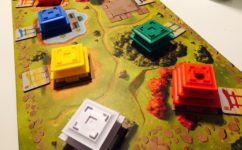
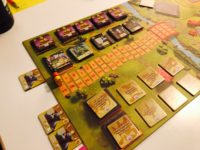
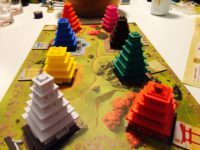
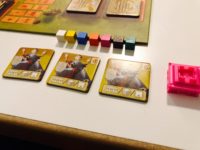




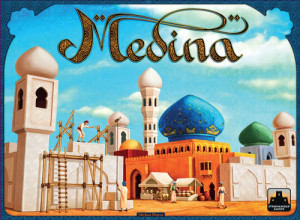
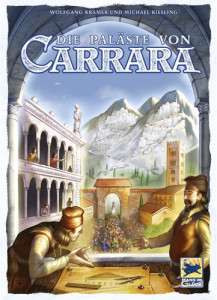

Sam says
It's a Reiner Knizia game! Maybe not my absolute favourite - but as he's designed hundreds of them and I've played about 40, that would be a tough ask. It's still good, and like almost every Knizia title, has something in it that makes you pause and consider... and reconsider. Knizia specialises in light rules but weighty decisions, and Tajuto certainly doesn't deviate from that. Okay, there are only three possible actions: draw a pagoda, place an offering, buy a tile. But the thrust of the game is the building, and you often can't be sure exactly what you're drawing from the bag. Add in the potential extra actions which you must pay for, and how paying effects your overall economy, and the possibility of buying extra action tiles and.... things get interesting. Compared to titles like auction-led Ra or tile-placement Babylonia , Tajuto is slightly oddball: an off-the-wall cousin from out of town here to tell you about the weird world back home. An interesting world though, and a slightly bonkers, skewy game.